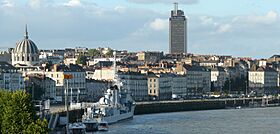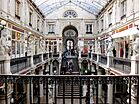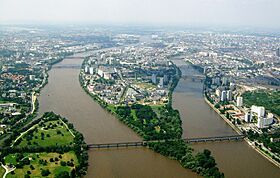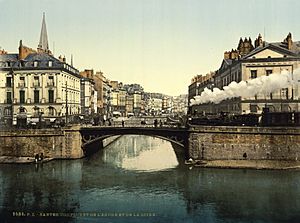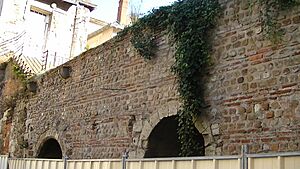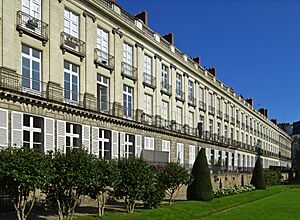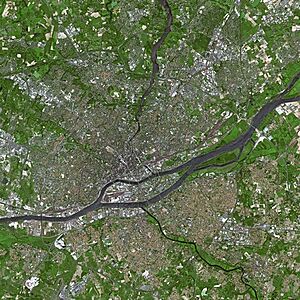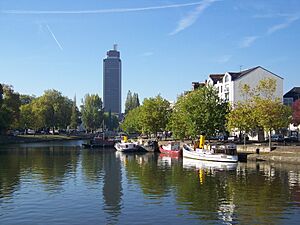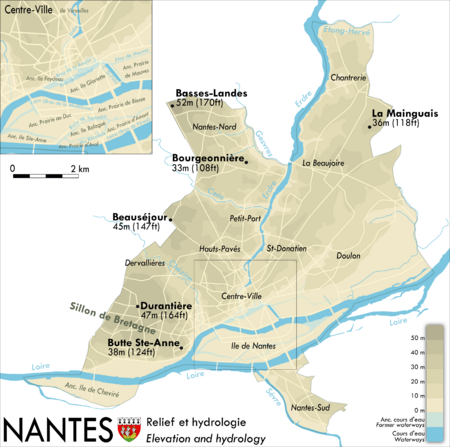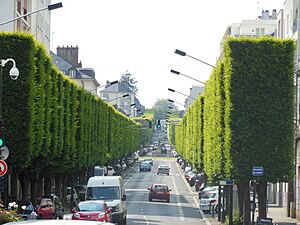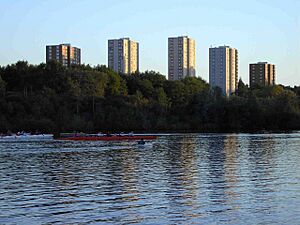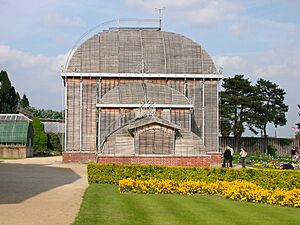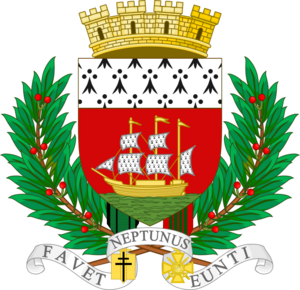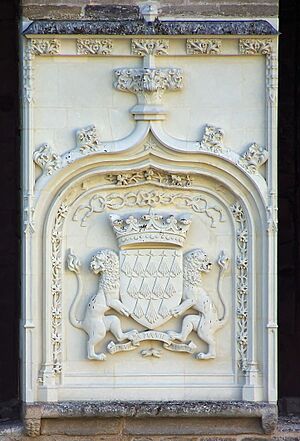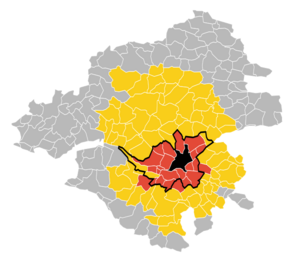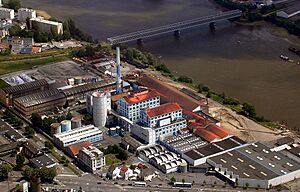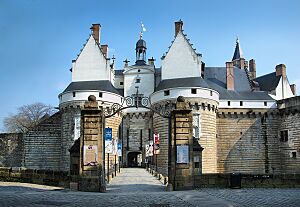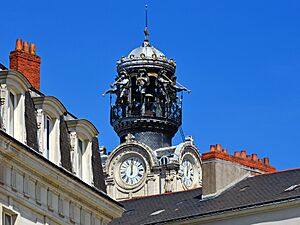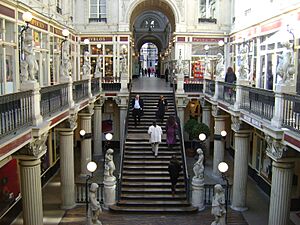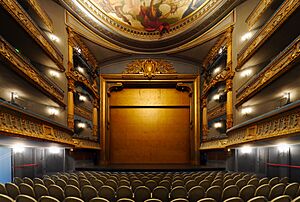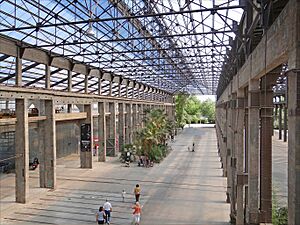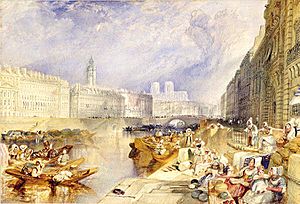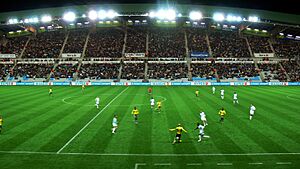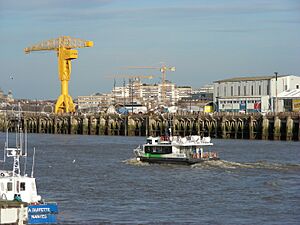Nantes facts for kids
Quick facts for kids
Nantes
|
|||
|---|---|---|---|
|
Prefecture and commune
|
|||
|
Top to bottom, left to right: the Loire in central Nantes; the Château des ducs de Bretagne; the passage Pommeraye, and the île de Nantes between the branches of the Loire
|
|||
|
|||
| Motto(s): | |||
| Country | France | ||
| Region | Pays de la Loire | ||
| Department | Loire-Atlantique | ||
| Arrondissement | Nantes | ||
| Canton | 7 cantons | ||
| Intercommunality | Nantes Metropolis | ||
| Area
1
|
65.19 km2 (25.17 sq mi) | ||
| • Urban
(2018)
|
498.6 km2 (192.5 sq mi) | ||
| • Metro
(2018)
|
3,471.1 km2 (1,340.2 sq mi) | ||
| Population
(2021)
|
323,204 | ||
| • Rank | 6th in France | ||
| • Density | 4,957.9/km2 (12,840.8/sq mi) | ||
| • Urban
(2018)
|
655,187 | ||
| • Urban density | 1,314.05/km2 (3,403.4/sq mi) | ||
| • Metro
(2018)
|
997,222 | ||
| • Metro density | 287.293/km2 (744.085/sq mi) | ||
| Demonym(s) | Nantais (masculine) Nantaise (feminine) |
||
| Time zone | UTC+01:00 (CET) | ||
| • Summer (DST) | UTC+02:00 (CEST) | ||
| INSEE/Postal code |
44109 /44000, 44100, 44200 and 44300
|
||
| Dialling codes | 02 | ||
| Website | metropole.nantes.fr | ||
| 1 French Land Register data, which excludes lakes, ponds, glaciers > 1 km2 (0.386 sq mi or 247 acres) and river estuaries. | |||
Nantes is a large city in western France. It sits on the Loire River, about 50 kilometers (31 miles) from the Atlantic Ocean. Nantes is the sixth-largest city in France. Its main city area has over 320,000 people. If you include the surrounding towns, nearly 1 million people live in the greater Nantes area.
Nantes is the capital of the Loire-Atlantique department and the Pays de la Loire region. Historically, Nantes was part of Brittany, a former duchy and province. Many people still feel a strong connection to Brittany here.
This city has a long history. It was an important port on the Loire River even in ancient times. In the 15th century, it was the main home for the dukes of Brittany. Later, in the 17th and 18th centuries, Nantes became the biggest port in France. It played a sad role in the Atlantic slave trade. After the French Revolution, the city faced tough times. But in the late 1800s, it grew again with industries like shipbuilding and food processing.
Today, Nantes is known as a "Gamma world city." This means it's an important global city, ranking third in France after Paris and Lyon. Nantes is also praised for its great quality of life. It even won the European Green Capital Award in 2013 for its efforts to reduce pollution, improve public transport, and protect nature.
Contents
- Understanding the Name of Nantes
- Exploring the History of Nantes
- Geography and Environment of Nantes
- How Nantes is Governed
- Population of Nantes
- Nantes's Economy
- Architecture and Buildings in Nantes
- Culture and Arts in Nantes
- Education in Nantes
- Sports in Nantes
- Getting Around Nantes
- Media in Nantes
- Famous People from Nantes
- See also
Understanding the Name of Nantes
The city of Nantes gets its name from an ancient tribe called the Namnetes. These people settled on the north bank of the Loire River around 200 to 100 BC. This spot was near where the Erdre River flows into the Loire. The name Namnetes might come from an old word meaning 'river' or 'valley'.
The Greek writer Ptolemy first wrote about the settlement. He called it Kondēoúinkon. The Romans later changed this to Condevincum. This name likely means 'confluence', referring to where the rivers meet.
Later, during the Roman period, the city became known as "Port of the Namnetes" or "City of the Namnetes." Over time, this name shortened and changed to what we know today as Nantes.
How People Say Nantes Today
In French, Nantes is pronounced "Nant." People from Nantes are called Nantais (for boys and men) or Nantaise (for girls and women). In the local Gallo language, it's spelled Naunnt or Nantt. In Breton, another language spoken in the region, it's called Naoned.
Nantes used to be called "Venice of the West." This was because it had many canals and river channels, like Venice, before they were filled in during the 1920s and 1930s. The city is also known as "the City of the Dukes." This nickname comes from its famous castle and its past as a home for the dukes of Brittany.
Exploring the History of Nantes
Ancient Times and Early Settlements
The first people lived in the Nantes area during the Bronze Age. They were likely drawn by small amounts of iron and tin. Around 900 BC, local industries started, with evidence of metalworking found in the city. Some historians think Nantes might have been an important Gaulish settlement called Corbilo.
Before the Romans arrived, Nantes was the capital of the Namnetes people. They were allies with another tribe, the Veneti. The Romans took control in the 1st century BC. Nantes was not a huge city under Roman rule. It had basic services like sewers and public baths. After attacks by German tribes around 275 AD, the people of Nantes built a strong wall. This wall was one of the largest in Gaul.
Christianity came to Nantes in the 3rd century. The first local martyrs were executed around 288-290 AD. A cathedral was built in the 4th century.
Nantes in the Middle Ages
During the early Middle Ages, Nantes was part of the Roman Empire. Around 490 AD, the Franks captured the city. It became a stronghold against the Bretons. In the 8th century, under Charlemagne, Nantes was part of a buffer zone protecting his empire from Breton attacks.
In 850, a Breton leader named Nominoe took Nantes. For a while, the city was vulnerable to Viking raids. A big Viking attack happened in 843, but the Vikings didn't settle then. Nantes became part of the Viking area in 919. However, the Norse were driven out in 937 by Alan II, Duke of Brittany.
Nantes became the center of a county in the 9th century. It often changed hands between the Dukes of Brittany and the counts of Anjou. In the 14th century, the House of Montfort became the dukes of Brittany. They chose Nantes as their main home. It was the largest town in Brittany, with over 10,000 people. The city's port activity grew, trading salt, wine, and fabrics with other countries. The 15th century was a "golden age" for Nantes. Many buildings, like the cathedral and castle, were built or rebuilt. The University of Nantes was founded in 1460.
The Modern Era and Big Changes
In 1491, Anne of Brittany married the King of France. This led to Brittany joining the French kingdom in 1532. Nantes kept its financial role, but Rennes became the main administrative center. During the French Wars of Religion (1562-1598), Nantes was a stronghold for the Catholic League. In 1598, King Henry IV of France signed the Edict of Nantes here. This law gave Protestants legal rights in France and ended the wars.
In the 17th century, Nantes's port grew. It started importing sugar from French colonies. By 1700, Nantes was the largest port in France. Sadly, this wealth was tied to the Nantes slave trade. From 1707 to 1793, Nantes merchants were responsible for nearly half of France's slave trade. They sold about 450,000 enslaved Africans in the West Indies.
The 18th century brought more wealth from trade. The city expanded beyond its old walls. Beautiful Neoclassical buildings and squares were built. Wealthy merchants built grand private homes.
The French Revolution and Its Impact
The French Revolution began in 1789. At first, some people in Nantes supported it. On July 18, 1789, locals took over the Castle of the Dukes of Brittany. However, rural western France, which was very Catholic, opposed the revolution. A rebellion started in the nearby Vendée region in 1793.
Nantes was an important city for the new French Republic. In June 1793, 30,000 Royalist troops attacked Nantes. Republican soldiers defended the city, and the Royalist leader was killed. After this, the government decided to remove anyone in Nantes who seemed to be against the revolution. Many people were arrested, and thousands died or were executed.
The revolution hurt Nantes's economy. The slave trade almost stopped, and trade with other European countries was cut off. Nantes never fully regained its wealth from the 18th century.
Growth of Industries in Nantes
In the early 1800s, the illegal slave trade briefly returned as a source of income. But new industries soon emerged. Nantes developed a canning industry using local vegetables and fish. Sugar imports also became important. By the mid-19th century, Nantes was falling behind other French ports. It was slow to adopt the Industrial Revolution.
However, in the second half of the 19th century, Nantes became a major industrial city. Families invested in successful businesses. By 1900, the main industries were food processing and shipbuilding. Famous biscuit makers like LU started here. The shipyards were among the largest in France.
As ships got bigger, they had trouble reaching Nantes up the Loire River. So, a new port was built in Saint-Nazaire at the river's mouth. Saint-Nazaire soon surpassed Nantes in port traffic. Nantes tried to stay competitive by building a long canal, but it was later abandoned as the Loire was dredged.
Reshaping the City: Land Reclamation
In the early 1900s, the many river channels in Nantes were seen as a problem. They made it hard for the city to grow and move around. Between 1926 and 1946, most of these channels were filled in. New roads replaced the waterways, changing the city's look. Islands in the old town, like Feydeau and Gloriette, became connected to the mainland. Other islands formed the Isle of Nantes.
As this work finished, World War II hit Nantes hard. The city was captured by Nazi Germany in 1940. In 1941, 48 civilians were executed in Nantes as revenge for a German officer's assassination. The city was bombed by Allied forces, especially in September 1943. Many industrial areas and parts of the city center were destroyed. About 20,000 people lost their homes. The Germans left Nantes on August 12, 1944.
Nantes After the War
After the war, Nantes saw many strikes and protests. A big strike by metalworkers in 1955 affected all of France. The city also had large protests during the May 1968 events. In the 1970s, many factories and shipyards closed. This was a tough time for Nantes's economy.
However, in the 1980s and 1990s, Nantes changed. It focused on service industries. The city worked to attract businesses by highlighting its great quality of life and cultural scene. Nantes became known as a creative place near the ocean. Local leaders also started to remember the city's history with the slave trade.
Geography and Environment of Nantes
Where is Nantes Located?
Nantes is in north-western France. It's close to the Atlantic Ocean, about 340 kilometers (211 miles) southwest of Paris. The city sits at a natural crossroads. It connects the ocean to the west, central France to the east, Brittany to the north, and the Vendée region to the south.
The city also shows a mix of architectural styles. North of the Loire, you see houses with slate roofs, typical of northern France. South of the river, homes often have low, terracotta roofs, like those in the Mediterranean. The Loire River also marks the northern limit for growing grapes.
Rivers and Waterways in Nantes
The Loire River is about 1,000 kilometers (621 miles) long. Its estuary, or wide mouth, starts in Nantes and stretches for 60 kilometers (37 miles). In the past, the Loire in Nantes had many channels and islands. These made it easier to cross the river and helped the city grow.
In the 1920s and 1930s, most of the smaller channels were filled in. Now, the Loire in Nantes has only two main branches, with the Isle of Nantes in between. The river here is tidal, meaning the water level changes with the ocean tides.
Two other rivers, the Erdre and the Sèvre Nantaise, also meet the Loire in Nantes. These rivers were important for connecting the city to the surrounding countryside. The Erdre even has a Japanese garden on Versailles Island, which was created in the 19th century.
Nantes's Landscape and Ground
Nantes is built on the Armorican Massif, an old mountain range that forms the backbone of Brittany. One part of this range, the Sillon de Bretagne, meets the Loire in Nantes. This creates cliffs above the river. The Butte Sainte-Anne, a hill 38 meters (125 feet) above sea level, is a natural landmark.
The Sillon de Bretagne is made of granite. Other areas are covered with silt and clay. Much of the old town and the Isle of Nantes are built on filled-in land. The highest points in Nantes are in the northwest, reaching 52 meters (171 feet). The lowest points, along the Loire, are only 2 meters (7 feet) above sea level.
Weather in Nantes
Nantes has an oceanic climate, meaning it's influenced by the nearby Atlantic Ocean. Winters are cool and rainy, with little snow. Summers are warm. It rains a good amount throughout the year. The climate is great for growing many different plants, from local vegetables to exotic trees.
| Climate data for Nantes-Bouguenais (Nantes Atlantique Airport), elevation: 27 m or 89 ft, 1991–2020 normals, extremes 1945–present | |||||||||||||
|---|---|---|---|---|---|---|---|---|---|---|---|---|---|
| Month | Jan | Feb | Mar | Apr | May | Jun | Jul | Aug | Sep | Oct | Nov | Dec | Year |
| Record high °C (°F) | 18.2 (64.8) |
22.6 (72.7) |
24.2 (75.6) |
28.3 (82.9) |
32.8 (91.0) |
39.1 (102.4) |
42.0 (107.6) |
39.6 (103.3) |
34.3 (93.7) |
30.2 (86.4) |
21.8 (71.2) |
18.4 (65.1) |
42.0 (107.6) |
| Mean maximum °C (°F) | 14.3 (57.7) |
15.9 (60.6) |
19.9 (67.8) |
23.4 (74.1) |
27.7 (81.9) |
31.7 (89.1) |
33.1 (91.6) |
33.0 (91.4) |
29.0 (84.2) |
23.3 (73.9) |
18.0 (64.4) |
14.5 (58.1) |
35.0 (95.0) |
| Mean daily maximum °C (°F) | 9.3 (48.7) |
10.5 (50.9) |
13.5 (56.3) |
16.2 (61.2) |
19.6 (67.3) |
23.0 (73.4) |
25.1 (77.2) |
25.4 (77.7) |
22.4 (72.3) |
17.6 (63.7) |
12.9 (55.2) |
9.8 (49.6) |
17.1 (62.8) |
| Daily mean °C (°F) | 6.4 (43.5) |
6.7 (44.1) |
9.2 (48.6) |
11.4 (52.5) |
14.7 (58.5) |
17.8 (64.0) |
19.7 (67.5) |
19.8 (67.6) |
17.1 (62.8) |
13.5 (56.3) |
9.4 (48.9) |
6.7 (44.1) |
12.7 (54.9) |
| Mean daily minimum °C (°F) | 3.4 (38.1) |
3.0 (37.4) |
4.9 (40.8) |
6.6 (43.9) |
9.8 (49.6) |
12.7 (54.9) |
14.3 (57.7) |
14.2 (57.6) |
11.8 (53.2) |
9.5 (49.1) |
5.9 (42.6) |
3.7 (38.7) |
8.3 (46.9) |
| Mean minimum °C (°F) | −4.3 (24.3) |
−3.6 (25.5) |
−1.3 (29.7) |
0.3 (32.5) |
3.7 (38.7) |
7.1 (44.8) |
9.6 (49.3) |
8.9 (48.0) |
5.9 (42.6) |
2.3 (36.1) |
−1.3 (29.7) |
−3.7 (25.3) |
−6.0 (21.2) |
| Record low °C (°F) | −13.0 (8.6) |
−15.6 (3.9) |
−9.6 (14.7) |
−2.8 (27.0) |
−1.5 (29.3) |
3.8 (38.8) |
5.8 (42.4) |
5.6 (42.1) |
2.8 (37.0) |
−3.3 (26.1) |
−6.8 (19.8) |
−10.8 (12.6) |
−15.6 (3.9) |
| Average precipitation mm (inches) | 87.9 (3.46) |
67.5 (2.66) |
58.4 (2.30) |
58.3 (2.30) |
61.0 (2.40) |
48.5 (1.91) |
44.2 (1.74) |
50.3 (1.98) |
59.5 (2.34) |
88.8 (3.50) |
94.1 (3.70) |
101.0 (3.98) |
819.5 (32.26) |
| Average precipitation days (≥ 1.0 mm) | 12.5 | 10.6 | 9.4 | 9.7 | 9.6 | 7.6 | 7.1 | 7.2 | 7.8 | 11.8 | 13.0 | 13.5 | 119.7 |
| Average snowy days | 1.3 | 2.0 | 0.3 | 0.0 | 0.0 | 0.0 | 0.0 | 0.0 | 0.0 | 0.0 | 0.3 | 0.9 | 4.7 |
| Average relative humidity (%) | 88 | 84 | 80 | 77 | 78 | 76 | 75 | 76 | 80 | 86 | 88 | 89 | 81 |
| Source: Meteo France Infoclimat (relative humidity 1961-1990) | |||||||||||||
| Climate data for Nantes-Bouguenais (Nantes Atlantique Airport), elevation: 27 m or 89 ft, 1961–1990 normals and extremes | |||||||||||||
|---|---|---|---|---|---|---|---|---|---|---|---|---|---|
| Month | Jan | Feb | Mar | Apr | May | Jun | Jul | Aug | Sep | Oct | Nov | Dec | Year |
| Record high °C (°F) | 17.6 (63.7) |
19.5 (67.1) |
23.2 (73.8) |
27.4 (81.3) |
30.3 (86.5) |
36.7 (98.1) |
36.3 (97.3) |
37.4 (99.3) |
34.3 (93.7) |
27.0 (80.6) |
20.9 (69.6) |
18.2 (64.8) |
37.4 (99.3) |
| Mean maximum °C (°F) | 11.3 (52.3) |
13.8 (56.8) |
15.4 (59.7) |
17.7 (63.9) |
23.5 (74.3) |
28.6 (83.5) |
28.5 (83.3) |
28.0 (82.4) |
24.6 (76.3) |
20.7 (69.3) |
14.6 (58.3) |
11.6 (52.9) |
28.6 (83.5) |
| Mean daily maximum °C (°F) | 9.2 (48.6) |
9.8 (49.6) |
12.4 (54.3) |
14.8 (58.6) |
17.9 (64.2) |
21.6 (70.9) |
24.1 (75.4) |
23.8 (74.8) |
21.8 (71.2) |
17.0 (62.6) |
12.1 (53.8) |
9.5 (49.1) |
16.2 (61.1) |
| Daily mean °C (°F) | 6.0 (42.8) |
6.5 (43.7) |
8.2 (46.8) |
10.3 (50.5) |
13.5 (56.3) |
16.8 (62.2) |
18.9 (66.0) |
18.5 (65.3) |
16.9 (62.4) |
13.3 (55.9) |
8.5 (47.3) |
6.3 (43.3) |
12.0 (53.5) |
| Mean daily minimum °C (°F) | 2.9 (37.2) |
3.2 (37.8) |
4.2 (39.6) |
5.8 (42.4) |
8.8 (47.8) |
11.8 (53.2) |
13.6 (56.5) |
13.3 (55.9) |
12.1 (53.8) |
9.1 (48.4) |
5.1 (41.2) |
3.4 (38.1) |
7.8 (46.0) |
| Mean minimum °C (°F) | −3.6 (25.5) |
−3.4 (25.9) |
1.2 (34.2) |
4.0 (39.2) |
7.4 (45.3) |
9.4 (48.9) |
11.5 (52.7) |
11.8 (53.2) |
9.4 (48.9) |
5.1 (41.2) |
2.7 (36.9) |
−0.3 (31.5) |
−3.6 (25.5) |
| Record low °C (°F) | −13.0 (8.6) |
−12.3 (9.9) |
−7.0 (19.4) |
−2.6 (27.3) |
−0.9 (30.4) |
3.8 (38.8) |
6.1 (43.0) |
5.8 (42.4) |
2.9 (37.2) |
−0.2 (31.6) |
−5.9 (21.4) |
−10.2 (13.6) |
−13.0 (8.6) |
| Average precipitation mm (inches) | 90.7 (3.57) |
59.9 (2.36) |
73.6 (2.90) |
44.7 (1.76) |
60.7 (2.39) |
37.8 (1.49) |
39.1 (1.54) |
35.5 (1.40) |
65.1 (2.56) |
66.0 (2.60) |
84.4 (3.32) |
77.0 (3.03) |
734.5 (28.92) |
| Average precipitation days (≥ 1.0 mm) | 13.0 | 11.0 | 11.5 | 9.5 | 10.5 | 7.5 | 6.5 | 6.0 | 8.0 | 10.5 | 10.5 | 11.5 | 116 |
| Average snowy days | 1.0 | trace | trace | 0 | 0 | 0 | 0 | 0 | 0 | 0 | trace | 1.0 | 2 |
| Average relative humidity (%) | 88 | 84 | 80 | 77 | 78 | 76 | 75 | 76 | 80 | 86 | 88 | 89 | 81 |
| Mean monthly sunshine hours | 72.2 | 99.3 | 148.4 | 187.0 | 211.3 | 239.5 | 266.8 | 238.9 | 191.3 | 140.5 | 91.2 | 69.9 | 1,956.3 |
| Percent possible sunshine | 27.0 | 35.0 | 41.0 | 46.0 | 46.0 | 51.0 | 56.0 | 55.0 | 51.0 | 42.0 | 33.0 | 27.0 | 42.5 |
| Source 1: NOAA | |||||||||||||
| Source 2: Infoclimat.fr (humidity) | |||||||||||||
How Nantes is Laid Out
Nantes has a typical French city layout. It has an old historical center with monuments and shops. This is surrounded by 19th-century neighborhoods. Beyond those are newer suburban homes and public housing.
The city center has a medieval part with narrow streets. You'll see old half-timbered buildings and newer stone ones. This area is popular with students. The eastern part of the center was for the wealthy. The western part, along the Loire, was built for merchants. It has wide avenues and grand homes.
After World War II, many new housing projects were built for the growing population. These areas are now being updated. The northern parts of the city, along the Erdre, include the main campus of the University of Nantes. Nantes has also grown south across the Loire into towns like Rezé.
The Isle of Nantes is a large island in the river. It used to have shipyards. Now, old industrial areas are being turned into offices, homes, and fun places. The city wants it to be an extension of the city center.
Green Spaces and the Environment
Nantes has over 100 public parks, gardens, and squares. The oldest is the Jardin des Plantes, a botanical garden from 1807. It has many exotic plants, including a 200-year-old magnolia tree. Other large parks include Parc de Procé and Parc du Grand Blottereau.
Natural areas, like the Petite Amazonie forest, add even more green space. In total, green areas make up 41 percent of Nantes. The city is working to reduce pollution and promote clean energy. Nantes has "ecodistricts" that aim for affordable, eco-friendly housing.
How Nantes is Governed
Symbols of Nantes
Nantes has used official symbols since the 14th century. The current coat of arms was first used in 1514. The ermine symbols represent Brittany. The green waves symbolize the Loire River.
The city's motto is "Favet Neptunus eunti." This means "Neptune favors the traveler." It was adopted in 1816. Nantes's flag has a white cross on a black one. It also features Breton ermines and the city's coat of arms. These crosses are old symbols of Brittany and France.
Nantes and Brittany's Connection
Nantes and the Loire-Atlantique area were historically part of Brittany. Nantes and Rennes were the traditional capitals. In 1789, Brittany was divided into five departments. When modern regions were created in the 20th century, Nantes was not included in the new Brittany region. Instead, it became part of the Pays de la Loire region.
This separation is still debated today. Many people in Nantes and Brittany want the areas to be reunited. Polls show a large majority in favor of this. Opponents say that Pays de la Loire would struggle without Nantes. Nantes city officials see the city as a unique place, connected to Brittany but also independent.
Sister Cities Around the World
Nantes has many twin towns and cooperation agreements with cities worldwide. These partnerships help build friendships and understanding between different cultures.
- Cardiff, Wales, United Kingdom (1964)
- Cluj-Napoca, Romania (1991)
- Jacksonville, United States (1984)
- Niigata, Japan (1999)
- Qingdao, China (2005)
- Saarbrücken, Germany (1965)
- Seattle, United States (1980)
- Suncheon, South Korea (2007)
- Tbilisi, Georgia (1979)
Nantes also has partnerships with cities in developing countries, including:
- Agadir, Morocco
- Dschang, Cameroon
- Grand'Anse, Haiti
- Kindia, Guinea
- Recife, Brazil
- Rufisque, Senegal
Population of Nantes
Nantes had 320,732 people in 2020, its largest population ever. The city has grown steadily since the Middle Ages. In 1500, about 14,000 people lived here. By 1793, it was 80,000. In 1800, Nantes was the sixth-largest French city.
The population continued to grow through the 19th century. In 1908, Nantes added the nearby towns of Doulon and Chantenay, gaining almost 30,000 people. Growth slowed in the 20th century as people moved to surrounding towns. However, since 2000, Nantes's population has been rising again. The greater Nantes area had nearly 908,000 people in 2013. It's expected to reach one million by 2030.
The population of Nantes is younger than the average for France. Many newcomers are students or adults moving for work. In 2020, about 40% of people over 15 had a higher-education degree.
Different Cultures and Languages
Nantes has always had different groups of people. In the 16th century, there were Spanish, Portuguese, and Italian communities. Later, an Irish community arrived. However, Nantes has always had fewer immigrants than other big French cities.
In 2013, about 8.5% of Nantes's population was born in another country. Most of these people were from Algeria, Morocco, or Tunisia. Others came from different African countries or the European Union.
The local dialect in Nantes is Gallo. However, standard French is mostly spoken in the city. The city supports bilingual schools that teach both French and Breton. It also uses bilingual signs.
Nantes's Economy
For centuries, Nantes's economy depended on the Loire River and the Atlantic Ocean. It was France's biggest harbor in the 18th century. During the Industrial Age, food processing became very important. Companies like LU (biscuits) and Saupiquet (canned fish) started here. The Nantes region is still France's largest food producer.
After the shipyards closed in 1987, Nantes focused on attracting service companies. It promoted itself as a creative and modern city near the sea. Large companies like Capgemini and SNCF opened offices here. Since 2000, Nantes has developed a business district called Euronantes.
Nantes has one of the best economies in France. It creates many new jobs. The greater Nantes area has over 42,000 businesses. The city is a major retail area with about 2,000 shops. Tourism is also growing, with two million visitors each year.
In 2021, most businesses in Nantes were in trade, transport, and services. Industry is less important now, but Nantes is still France's second-largest center for aeronautics. Airbus produces parts for its planes here. The Atlanpole technopole helps develop technology and science sectors. Nantes also has a growing creative industry, with many companies in design, media, and digital technology.
Architecture and Buildings in Nantes
Most buildings in Nantes are relatively new, built in the 20th century. The city has 127 buildings listed as historical monuments. Many old buildings were made of tuffeau stone, a light stone common in the Loire Valley. Strong granite was used for foundations.
Some parts of the Roman city wall from the 3rd century still exist. The Saint-Étienne chapel, from 510 AD, is one of the oldest structures. Medieval walls were built in the 13th and 15th centuries. Some parts, like the Porte Saint-Pierre (built in 1478), remain.
In the old town, Le Bouffay, you can still see 15th and 16th-century half-timbered houses. The large, Gothic Nantes Cathedral was built over many centuries, from 1434 to 1891. It has a beautiful tomb of Francis II, Duke of Brittany. The Gothic castle, Castle of the Dukes of Brittany, is a main landmark. It was started in 1207 and served as both a military fort and a home for the dukes.

In the 18th century, Nantes grew west of its medieval center. Wealth from trade allowed for many public buildings. These include the Graslin Theatre (1788) and the stock exchange (1790). Place Royale, completed in 1790, has a large fountain with statues representing Nantes and the Loire River. Many private homes from this era have a unique "Nantais baroque" style.
Most churches in Nantes were rebuilt in the 19th century. They often used the Gothic Revival style. This includes the two basilicas, Saint-Nicolas and Saint-Donatien. The Passage Pommeraye, built in 1840-1843, is a famous multi-story shopping arcade.
Modern architecture includes converted factories on the Isle of Nantes. The old Lefèvre-Utile biscuit factory is known for its Tour Lu tower. Two old cranes in the harbor are also famous landmarks. Recent buildings include the courts of justice, designed by Jean Nouvel in 2000.
Culture and Arts in Nantes
Museums to Explore

Nantes has several interesting museums. The Fine Art Museum is the largest. It has a huge collection of art, from old Italian paintings to modern sculptures. The Historical Museum of Nantes, located in the castle, tells the story of the city. It has items showing Nantes's history, including its role in the Atlantic slave trade.
The Dobrée Museum houses archaeological finds and decorative arts. It includes a golden reliquary made for Anne of Brittany's heart. The Natural History Museum of Nantes is one of the biggest in France. It has over 1.6 million animal specimens.
The Machines of the Isle of Nantes, opened in 2007, are very popular. They feature amazing automatons and giant walking machines, like a 12-meter (39-foot) tall elephant. Other museums include the Jules Verne Museum, dedicated to the famous author born in Nantes, and the Planetarium. The HAB Galerie is Nantes's largest art gallery, showing contemporary art.
Places for Shows and Events
Le Zénith Nantes Métropole is a large indoor arena in Saint-Herblain. It can hold 9,000 people and hosts big concerts. La Cité, Nantes Events Center is a 2,000-seat auditorium for concerts and exhibitions. The Graslin Theatre, built in 1788, is home to the Angers-Nantes Opéra.
The old LU biscuit factory has been turned into Le Lieu unique. It's a cultural center with a restaurant, bookshop, and spaces for art, music, and dance. La Fabrique has music studios and concert venues, including Stereolux for rock concerts and Pannonica for jazz. Nantes also has several cinemas.
Festivals and Fun Events
The Royal de Luxe street theatre company is based in Nantes. They are famous for their huge marionettes, like the Little Giant and the Sultan's Elephant, which perform in cities around the world. The Machines of the Isle of Nantes also put on shows and performances.
The Estuaire art exhibitions have left permanent artworks along the Loire estuary. These inspired the Voyage à Nantes, a summer event with contemporary art exhibitions across the city. A green line painted on the pavement guides visitors to the artworks and landmarks. Some permanent sculptures include Daniel Buren's Anneaux (rings along the Loire).
La Folle Journée is a popular classical music festival held every winter. It lasts for five days and has a different theme each year. The concept has spread to other cities like Tokyo. The September Rendez-vous de l'Erdre combines a jazz festival with a boating show. All concerts are free.
The Three Continents Festival is an annual film festival. It focuses on films from Asia, Africa, and South America. Nantes also hosts other film festivals and the Utopiales science fiction festival.
Slavery Memorial
Along the Loire River, there is a special memorial to the abolition of slavery. A path has 2,000 glass inserts. Over 1,700 of them remember the names of slave ships from Nantes. The others name ports in Africa, the Americas, and the Indian Ocean.
The path leads to an underground part of the memorial, closer to the river. Here, you can read the Universal Declaration of Human Rights and the word "freedom" in 47 languages. Quotes from important figures like Nelson Mandela and Dr. Martin Luther King Jr. are etched on glass walls. At the end, a room shows a timeline of when slavery was abolished around the world.
Nantes in Books and Movies
Nantes has inspired many artists and writers. Some say it was the birthplace of surrealism, a famous art movement. The writer André Breton called Nantes "perhaps with Paris the only city in France where I have the impression that something worthwhile may happen to me."
The city is the hometown of French film director Jacques Demy. Two of his films, Lola and A Room in Town, were set and filmed in Nantes. The famous Passage Pommeraye even appears in The Umbrellas of Cherbourg.
Nantes is also mentioned in many songs. The American band Beirut has a song called "Nantes." French singers like Barbara and Renan Luce have also sung about the city. "Dans les prisons de Nantes" is a very popular folk song.
The British painter J. M. W. Turner visited Nantes in 1826. He painted a famous watercolor of the city, which is now in the Historical Museum.
Delicious Food in Nantes
The Nantes region is known for its market gardens. It produces many vegetables like corn salad, leeks, and carrots. Nantes also has a wine-growing region, the Vignoble nantais. It's famous for dry white wines like Muscadet, often served with seafood.
Local fishing ports provide fresh shrimp and sardines. Eels and other fish are caught in the Loire. You can find these fresh products at the city's eighteen markets, including the well-known Talensac covered market.
Beurre blanc is Nantes's most famous local specialty. It's a creamy sauce made with Muscadet wine, perfect with fish. Other local treats include LU and BN biscuits, especially the Petit-Beurre (made since 1886). You can also try berlingot nantais (flavored sweets), rigolette sweets with marmalade, and gâteau nantais (a rum cake). Local cheeses like Le Curé Nantais and fouace (a star-shaped brioche) are also popular.
Education in Nantes
The University of Nantes was first founded in 1460. It was closed in 1793 but reopened in 1961. Today, the university has about 30,000 students. The greater Nantes area has a total of 53,000 students. The university is part of a group of seven universities in western France.
Nantes also has many other colleges and higher education institutes. Audencia is a top-ranked private business school. There are five engineering schools, including École centrale de Nantes and IMT Atlantique. Other schools include a design school, a merchant navy school, and a fine-arts school.
Sports in Nantes
Nantes has several large sports facilities. The biggest is the Stade de la Beaujoire, a football stadium with 37,473 seats. It hosted matches for the UEFA Euro 1984 and the 1998 FIFA World Cup. The Hall XXL is a large exhibition hall that can also be used for sports events.
Smaller venues include the Palais des Sports and the Mangin Beaulieu sports complex. The Erdre River has a marina and a center for rowing, sailing, and canoeing. The city also has six swimming pools.
Six Nantes teams play at a high national or international level. The most famous is FC Nantes, a football club that has won many French titles. In handball, volleyball, and basketball, Nantes has men's and women's teams in the French first division.
Getting Around Nantes
Roads and Trains
Nantes is connected to Paris by the A11 motorway. It's also part of the Way of the Estuaries, a network of motorways that connects northern France to the Spanish border. These motorways form a 43-kilometer (27-mile) ring road around the city.
Nantes's central railway station is very busy. TGV high-speed trains connect Nantes to Paris in just over two hours. The station also has trains to other major French cities like Lille, Lyon, and Marseille. Local trains serve nearby towns.
Nantes Atlantique Airport is southwest of the city center. It serves about 80 destinations in Europe, Africa, the Caribbean, and Canada. Air traffic has grown a lot in recent years.
Public Transport in the City
Public transport in Nantes is managed by "Tan." In 1826, Nantes had one of the world's first horse-drawn bus systems. The city built its first tram network in 1879. Like many European cities, Nantes removed its trams in the 1950s. However, in 1985, Nantes was the first French city to bring trams back!
Today, Nantes has a large public transport network with trams, buses, and river shuttles. The Nantes tramway has three lines. The Navibus, a river shuttle, has two lines on the Erdre and Loire rivers.
Nantes has also developed a tram-train system. This allows suburban trains to run on tram lines. The city has two tram-train lines, connecting Nantes to Clisson and Châteaubriant. The Bicloo bicycle-sharing system has 880 bicycles at 103 stations.
Public Transportation Statistics
On average, people in Nantes spend about 40 minutes commuting with public transit on a weekday. About 7% of riders travel for more than 2 hours each day. The average wait time at a stop is 12 minutes. The average distance for a single trip is 5 kilometers (3 miles).
Media in Nantes
The main local newspapers are Ouest-France and Presse-Océan. Ouest-France is the best-selling newspaper in France. There are also free newspapers like 20 Minutes. Local magazines cover cultural life, urban planning, and business.
National radio stations like FIP and Fun Radio have local outlets in Nantes. France Bleu Loire-Océan is the local public radio station. Several private local stations also broadcast, covering music, news, and cultural topics.
Nantes is home to France 3 Pays de la Loire, a local TV station for the region. Télénantes is a local private TV channel that focuses on news.
Famous People from Nantes
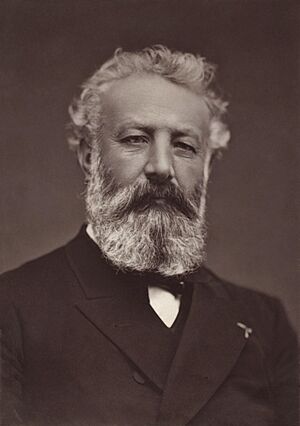
Many notable people were born or lived in Nantes:
- Arthur I (1187–c. 1203), a Duke of Brittany
- Duchess Anne of Brittany (1477–1514), who was twice queen of France
- Joseph Fouché (1763–1820), an important statesman
- Jules Verne (1828–1905), the famous science fiction writer
- Georges Clemenceau (1841–1929), a statesman
- Aristide Briand (1862–1932), who won the Nobel Peace Prize
- André Breton (1896–1996), a writer and poet, who studied medicine here
- Olivier Messiaen (1908–1992), a famous composer
- Jacques Demy (1931–1990), a film director
- Éric Tabarly (1931–1998), a well-known yachtsman
- Christine and the Queens (born 1988), a popular singer and songwriter
- Madeon (born 1994), a famous DJ
|
See also
 In Spanish: Nantes para niños
In Spanish: Nantes para niños


